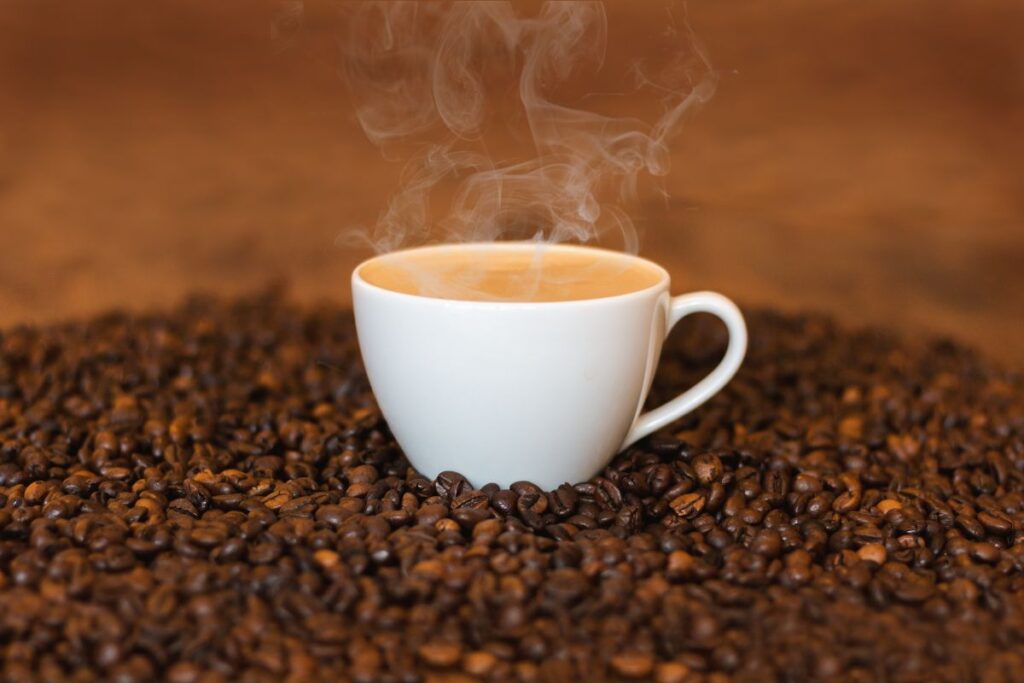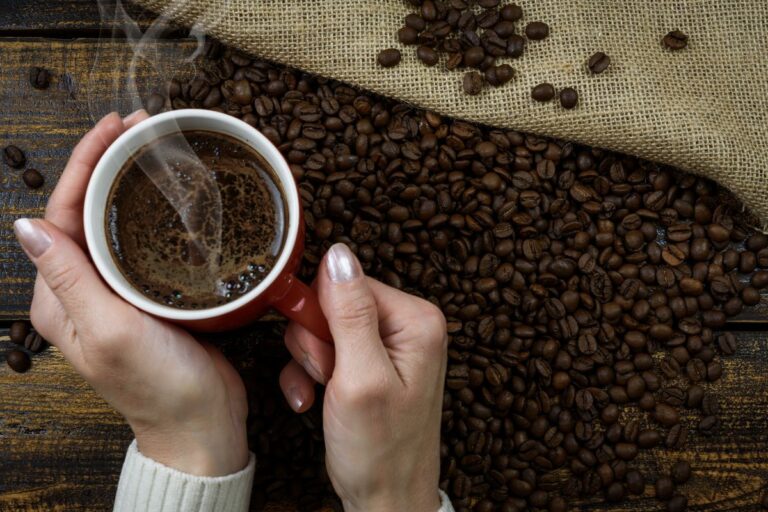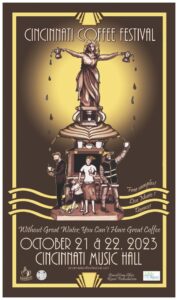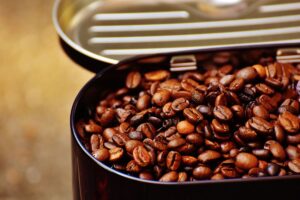Beginner’s guide to coffee grind and coffe grinders – your top FAQs answered.
By Andrew and Marcelo.
Affiliate disclosure
This page may contain affiliate links – we may earn a small commission when you make a purchase through these links. This is at no extra cost to you.
How Does Coffee Grind Affect Coffee Taste And Flavor?
So, you are tired of your typical coffee grounds from the popular brands such as Folgers and Maxwell House.
You are ready to elevate your coffee game by buying whole coffee beans that are more expensive.
You also bought a grinder to help you make the perfect cup.
But this is a new experience for you. You are not sure how fine or coarse the grind should be.
How does coffee grind affect taste and flavor?
Why is Grind Size Important? Does Grind Size Affect Coffee Flavor?
The size of your coffee grind changes the extraction and thus, overall flavor and taste of your cup.
Extraction is the process by which the water passes through the coffee grounds, changes their chemical composition to make the beverage we all know and love.
If the grind size is not just right, your cup of joe will end up over or under extracted.
The Taste of Over-Extracted Coffee: Bitter, Dry, or Astringent
Coffee that is over-extracted will have a bitter taste.
Yes, dark chocolate is also bitter and sometimes coffee can have this flavor.
But if it is well over-extracted, the bitter taste can be overpowering and unpleasant.
It can also have a very dry and unexciting flavor.
Coffee has many chemicals in it. If these chemicals, like lipids, acids, and sugars are removed by the water during extraction, your coffee will not be as good.
Over-extracted coffee may also affect the astringency.
Astringent coffee will make your tongue feel scratchy and dry.
You may feel like the coffee, which is supposed to moisturize the mouth, removes all the moisture instead. This is astringency and it caused when the process of extraction extracts all of the nutrient from the coffee’s plant fibers.

The Taste of Under-Extracted Coffee: Salty, Sour, or Not Sweet
Coffee that is under-extracted may have a salty taste. This is caused by the water not being in contact with grounds for a sufficient period of time to properly extract all of its flavors.
Under-extracted coffee can also taste sour because it hasn’t been brewed enough to go through the cycles of flavor extraction.
It may also not taste sweet.
Again, this is because the water did not sufficiently process the chemicals that produce the sweetness in your coffee.
How Do You Get the Flavor You Want from the Extraction Process?
Why, choosing the right grind size, of course!
While brew times and the ratio of coffee to water all affect the extraction process and ultimately the flavor of your cup, grind size is equally important.
How Does Grind Size Affect the Taste of Your Coffee?
What are the effects of coarse or fine coffee grounds on extraction?
Grind size affects extraction because the size of the grind determines whether or not the water can pass through more or less freely through the coffee grounds.
As a rule of thumb, sugar-like consistency is a good middle ground for ground coffee.
Coarser Grind: Too Coarse and it Will Taste Sour from Under-Extraction
Coase coffee grounds can be completely submerged in the water, because it has a low surface area.
This means it takes longer to extract.
If you grind your coffee too coarse, the extraction will not be up to par and you will end up with a cup that tastes too watery or sour, without the sweetness that we all like.
Finer Grind: Too Fine Will Result in Over-Extraction
Finer grounds have a higher surface area, which means the extraction will be faster and easier.
However, if you grind your coffee too fine, your coffee will be over-extracted, which will produce a bitter cup.
Different Types of Coffee Require Different Grind Sizes
How does grind size affect the flavor of different kinds of coffee?
Espresso: Uses Finer Grounds
Espresso is always made with finely ground coffee.
The finely ground coffee, again, has a higher surface higher so extraction is much easier, and it is perfect as the coffee is brewed under high pressure for twenty to thirty seconds.
And because of this quick brew time, more of the coffee’s solubles are extracted with a finer grind.
French Press Coffee: A Different Process Entirely
Coffee is made using a French press by submerging the grounds in water for a number of minutes.
Coarser grind should be used to prevent over-extraction.
Pour-Over Coffee: Medium Grounds
With pour over brewers, a medium grind should be used. Erring to the side of coarser grind is a safe bet, if not sure.
Turkish Coffee: Very Fine
Turkish coffee, made using a moka pot, should be brewed with coffee grounds that are finer than for espresso.
Now let’s switch gears and talk about coffee grind strength.
Coffee Grind Strength: How Does Grind Size Affect Strength and Caffeine Content
We all love that extra caffeine jolt in the morning to get us going and start our day on the right foot.
When making coffee in the morning and you want the extra energy, remember that grind size does matter.
The finer the coffee grounds are, the more caffeine will be extracted from them, thus producing a stronger cup.
Remember, this is because the coffee grounds have a higher surface area, which means the water extracts more of the coffee’s chemicals.
Conversely, coarsely ground coffee will produce a weaker cup because it has a lower surface area.
Conclusion
Coffee grind size definitely plays a big role in how your cup will turn out.
It affects the extraction and determines whether your coffee will be over-extracted, which produces a bitter cup, or under extracted, which produces a sour and watery taste.
Are Coffee Grinders And Spice Grinders the Same?
This is a common misconception, even though a proper coffee grinder has nothing to do with a spice grinder.
They are not the same at all.
Spice grinders – Not Best Suited for Coffee?
Consisting of 2-4 blades that spin, effectively cutting or mincing the contents of the grinder.
It works much like a blender would.
You pour the contents in, turn it on, then pour the contents out.
Spice grinders are designed to hold a small amount of contents. This is why they are so perfect for spices and condiments: because they usually use a small amount of those, too.
The same applies to coffee.
Whenever you have to grind coffee, you only need to grind a small amount.
So basically, spice grinders are the perfect fit for coffee in terms of quantity.
But what about quality, more specifically, the quality of the grind?
Can blades provide an even grind, the kind that you need for espresso?
As we will see in the next section, no, they cannot.
By the way, have you had a look at our deals page yet?
Burr grinders – The Ideal Coffee Grinder
Burr grinders are made up of two dented discs, which work by rotating in opposite directions.
It’s actually the same way grain is milled, only grain milling is done at a higher scale. So it is the same principle applied to a much smaller device.
The way they work is by allowing space between them for the beans to pass through; the less space there is, the finer the grind.
Conversely, the more space there is, the coarser the grind.
This is the way that coffee has been ground: because of the need to have different grind sizes depending on the brew method.
For example: French press needs a coarser grind, so you can steep it for a long time without it going bitter; and espresso needs a finer grind so it can be extracted quicker (espresso takes about 20 seconds, while French press coffee takes three minutes).
Why Burrs and Not blades?
Not Precise Enough.
The main reason why blades are a bad fit for coffee is because they are not a precise tool. They simply chop everything in their path as they go around thus not delivering a consistent result; some of your ground coffee will be fine grind, perfect, while some of it will be coarse to different sizes.
Burrs don’t have this problem because they can be adjusted to whatever size you need. And they are a very precise tool: since the space between them doesn’t vary while grinding, the grind size will be consistent—although not all grinders are equally consistent.
It’s a Matter of Design.
The second reason is that blade grinders were not designed with coffee in mind. Coffee grinders have bean hoppers, for example, which are receptacles in which to store beans.
This way you can have your grinder ready to go whenever you need coffee, while with blade Grinders you need to pour coffee every time you need to use it, which is less convenient.
Spice Grinders Will Burn Your Coffee
And last but not least, blade grinders reach very high speeds that will cause heating of whatever is inside the grinder, in this case, ground coffee.
And ground coffee is actually very sensitive to heat, which means that blade Grinders can actually burn your coffee if you grind for long enough.
And with blade grinders being as inconsistent as they are, you usually have to grind longer than you would if you were using a burr grinder.
Keep in mind, however, that even though we’re listing all the negative aspects of blade grinders, they’re actually really good for other uses—just not for coffee.
Should Espresso Grinds Be Fine Or Coarse?
How is Espresso Made
The main question to be answered here is why do we need fine grind for espresso?
Espresso is made using very little water.
The usual coffee-water ratio in black coffee is around 1:12.
With espresso, though, it’s around 1:1 or 1:2.
How can we do that?
By using pressure to force the water though the grounds!
This greatly accelerates the extraction process.
So we don’t need as much water, and we also don’t take as long making the coffee! What would usually take between one and three minutes, is done in around twenty seconds.
But to achieve this, we need a very fine grind.
The finer the grind is, the easier it is to extract the coffee from it—which is key for espresso.
By the way, have you had a look at our deals page yet?
So Why Isn’t Coarse Ground Used?
Coarse grind just can’t be extracted in the same amount of time.
That’s why coarse grind is usually used for steep-based brewing methods.
That mainly means the French press.
With steeping, you just need to wait longer.
But espresso, like pour over, or the moka pot, needs water to run through the grounds.
So, basically, if you want coarse grounds to be extracted properly, you need to run more water through them.
This is particularly bad for espresso, which is characterized by using little water—add more water and you’ll lose all the flavor!
So, for years, this was a big taboo. Coarse grind for espresso? Unthinkable!
Revolutionizing Espresso
Usually, you wouldn’t be able to make espresso using coarse grind.
But it can be done.
The best example of this is the Aeropress.
The Aeropress lets you create pressure, so it’s a lot like espresso, but it also lets you steep the coffee.
By steeping the coffee, you give it enough time for it to properly extract, and by the time you push down it’ll be ready.
You can actually make a coarse grind espresso!
And while this is probably one of the first brewing methods that let us do this, home espresso. machines are getting ever more sophisticated: you can now pre-infuse a shot, which can make coarse grind viable for making espresso!
Really, it’s all about creativity.
Conclusion: Can I or Can I Not Use Coarse Grind for Espresso?
Well, it depends. As I mentioned before, Aeropress would be the ideal.
You can’t make actual espresso with an Aeropress, though.
It’s espresso-like coffee, and even if it’s very close to it, it’s not espresso.
And there’s many of the newer home espresso machines that will let you pre-infuse the grounds long enough for it to work.
And there’s another brewing method that uses coarse grind: cold brew.
Cold brew, like the French press, works by steeping.
This steeping takes place over a long time—anywhere between eight and twenty-four hours!
Fine grind would result in a muddy drink, so coarse is used.
The flavor might be different, but the coffee-water ratio is actually similar.
Cold brew uses a 1:4 or 1:2 ratio, making it concentrated enough to feel like an espresso.
The answer, then, is yes. You can use coarse grind—but only with certain machines.
If you own one of these newer machines, go ahead and experiment.
If you own an Aeropress, try using coarse grind!
Cold brew can actually be made using just a mason jar, so that’s one you could try right now at home.
Just get some coarse ground coffee and use a 1:2 ratio to create your own coarse grind espresso!
How Do Coffee Grinders Work?
Burr grinders VS blade grinders
To understand what a “coffee grinder” is, we need to talk about burr grinders and blade grinders.
Or, actually, we just need to talk about blade grinders.
Blade grinders are a type of grinder that uses blades -much like a food processor- to cut things. These are marketed as “coffee” or “spice” grinders.
For spice grinding they are okay, but for coffee grinding they are atrocious.
Blade grinding does not provide even grinding, which will result in bad coffee.
An actual coffee grinder has to be a burr grinder.
But then you’d ask: what are burr grinders?
What are burr grinders
Burrs are two flat, dented discs on top of each other that rotate in opposite directions.
This is the same way that grain is milled – and that’s exactly how coffee is ground down.
How do burr coffee grinders work?
Unlike mills, these burrs can be farther or closer from each other.
Depending on the distance, you get a different size, which is necessary for coffee: some brewing methods need coarser grinds, like French press coffee, while espresso needs a much finer, powder-like size.
This is why you just can’t have a blade grinder for coffee. It will cut the beans up, and there will be some fine powder, some big chunks, etc, etc.
If the coffee is uneven the water won’t flow evenly through the grounds, meaning that extraction will be very poor. This can lead to plain coffee that’s almost flavorless to coffee that is too sour to drink.
And this is why we always recommend not using a blade grinder.
While these are much cheaper and may sometimes be marketed as “coffee” grinders, they are nothing of the sort.
What are manual coffee grinders?
These are little grinders that have seen a great boost in popularity the last few years.
They are much smaller and much cheaper than the usual coffee grinder: while a good home coffee grinder can cost between 200 and 500 dollars, a manual one usually is between 40 and 100 dollars, making them several times cheaper.
Manual coffee grinders are different in several respects. They don’t have a bean hopper or bean container, meaning that you have to put the beans in them each individual time that you’re grinding.
They don’t grind directly into the portafilter, either, but have a small grounds container.
This same container is usually rather small, so you can’t really rely on manual grinders for big batches of coffee – usually, they hold enough for 3, 4 cups at most.
Either way, because you have to manually rotate the burrs, you’ll probably be tired by cup 2.
Manual grinders also tend to have less grind settings, which have to be manually inputted, too.
In general manual grinders are much less convenient in some ways while having convenient aspects like being cheaper and more portable.
How do manual grinders work?
Exactly the same way as regular burr grinders. They have two burrs that rotate opposite of each other, except that it is you that has to make them move.
You have to manually crank it so that they move: this is a fun activity, sure, but can be tiring after a little bit.
Some manual grinders have easier operation than others, but in general you have to hold them with one hand while using the other hand to move the burrs. Depending on the individual grinder you’re using, this takes a few minutes to yield enough grounds for two cups.
What’s better: manual or automatic coffee grinder?
This really depends on the use you are going to give them. Commercial grinders have to be automatic, because nobody has time to grind coffee beans by hand when there are 5 people in the line.
For the longest time, automatic grinders were seen as the only option, but that’s because no one had thought of manual grinders.
Like with espresso machines, grinders were something that was very expensive and only coffee shops had them.
With the wave of home espresso machines that created different expectations, grinders also gradually transformed.
And so, manual grinders became a really good alternative to automatic grinders that can be more expensive, bigger, and more noisy.
Manual grinders were virtually non-existent in the 2000s and are now one of the most popular types of grinders for home brewing.
Photos by Photo-Mix Xompany and Pfüderi.





